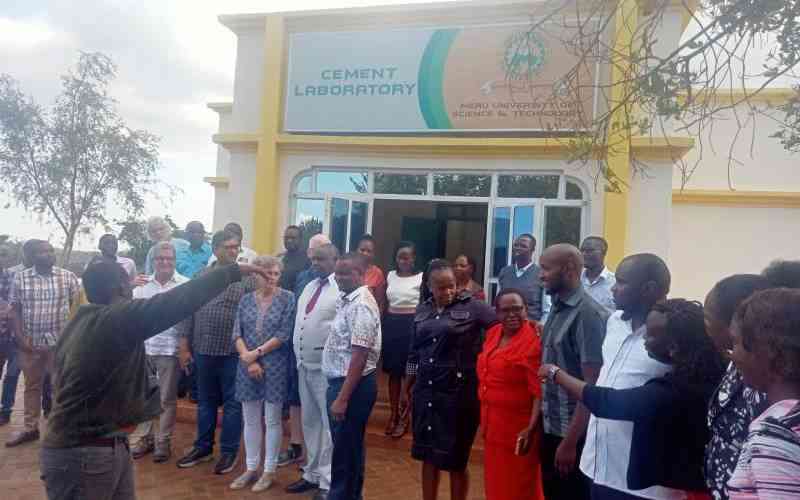
Scientists at Meru University of Science and Technology (MUST) have innovated clay-based cement, to address climate change and lower the cost of housing.
The clay-based cement is an innovation that aims at offering alternative climate-friendly and cheaper cement to address the rising demand for affordable housing.
Dr Joseph Mwiti, who is in charge of TRC Africa at the university, which is supporting the uptake of Limestone Calcined Clay Cement (LC3) in Sub-Saharan Africa, exuded confidence that the cement will be in the market and will go a long way in mitigating effects of climate change.
Mwiti is also the Director, of the Institute of Cement and Concrete at the varsity.
He said the innovation targets to reduce the clinker, the solid material in the manufacture of conventional cement, which is blamed for high emissions of carbon dioxide.
Mwiti explained that by switching to clay-based cement, the industry will reduce the amount of carbon dioxide and the cost of production.
"Cement industry emits between six to eight per cent of carbon dioxide emissions, and it places the cement industry as the third polluting industry in the world," he said during a tour of a clay-based cement laboratory at the university.
Top scientists, from various universities, including from Israel, Switzerland and Cuba, visited the MUST main campus in Nchiru, Tigania West sub county for the opening of the alternative cement laboratory and resource cement.
- Anthropologist merges science and culture to combat East Coast Fever
- Tech professionals urged to be inclusive in innovation
- Baku climate conference ignores Africa's power to capture carbon emissions
Keep Reading
The centre will host scientists, who are putting final touches on the product and serve as a resource centre for the innovation that they hope to commercialise and supply to Africa.
The partners have been working together to develop the product.
He said the resource centre will be dedicated to supporting the uptake of limestone calcined clay cement in Sub-Saharan Africa.
Mwiti said after the cement is tested at laboratory and industrial scale using state-of-the-art equipment, the aim is mass production.
"LC3 is cost-saving. We will be able to realise affordable housing in our country and other essential infrastructure that we require in the built environment. This type of cement has the potential to also set up new industries where we have clay. As it is, cement industries are located in some localized places along the Rift Valley and along the Coast of Kenya," he said.
"But now we have a chance to set up cement industries in the northern part of Kenya and places where we have a lot of clay. That means a lot of job creation and a lot of development," he added.
The don said harnessing readily available clay will reduce clinker imports.
"We have for a long time been importing the clinker, and the prices of cement have been prone to price volatility due to fluctuations in the international market as we import clinker. But now we have a chance to use less clinker, and the more we use less clinker, the more we can fight climate change and lower the cost of cement," he said.
"We are part of the fight against climate change, and part of the solution to the much-needed cement, because it is a major ingredient in construction activities, in terms of cost and in terms of accessing it in Sub-Saharan Africa," Mwiti said.
Prof Karen Scrivener of EPFL, a university in Switzerland, hailed the launch of the centre.
"It should help the whole of Africa to develop this important material which can address the huge need for housing with minimum climate impact because we have to look at these two things. We have to look at climate, but we cannot forget people need houses," Prof Scrivener said.
 The Standard Group Plc is a multi-media organization with investments in media platforms spanning newspaper print
operations, television, radio broadcasting, digital and online services. The Standard Group is recognized as a
leading multi-media house in Kenya with a key influence in matters of national and international interest.
The Standard Group Plc is a multi-media organization with investments in media platforms spanning newspaper print
operations, television, radio broadcasting, digital and online services. The Standard Group is recognized as a
leading multi-media house in Kenya with a key influence in matters of national and international interest.




